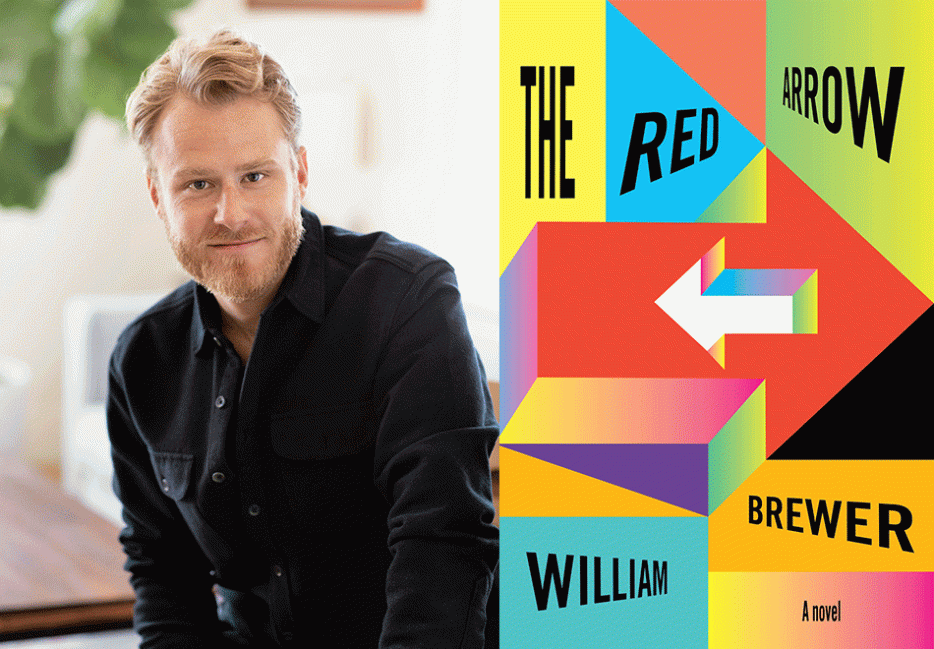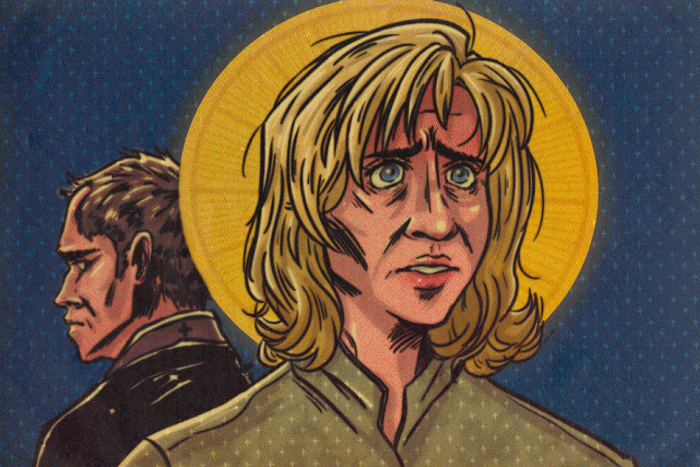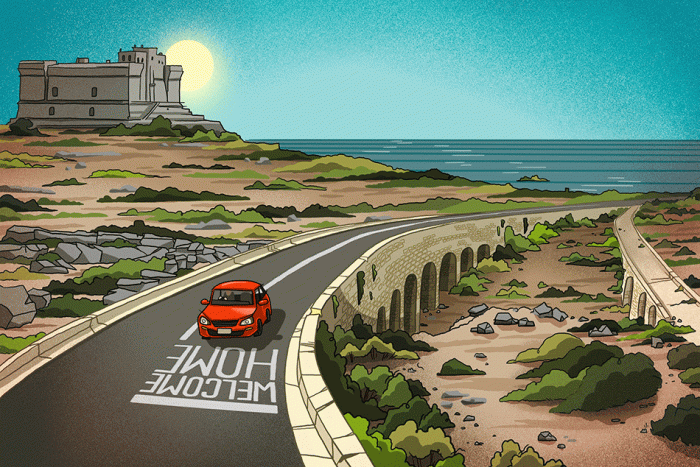William Brewer’s The Red Arrow (McClelland & Stewart) is a sweeping work of magical realism that follows a promising millennial artist and author whose recent successes are undercut by his severe depression and suicidal ideation.
He refers to his condition as “the Mist.” It obscures all love, hope and joy, leaving him feeling like “an abscess on the smile of reality.” The Mist first appears during the narrator’s childhood in West Virginia, following the Great Monongahela River Chemical Spill of 1996. After the chemical spill infiltrates the water supply in his hometown of Morgantown, he recounts in harrowing details its impact on him, his family, school and community. However, after he receives an advance for an epic novel about West Virginia, he struggles to translate this first scene into literature.
Soon the Mist takes over his apartment and when others speak to him the Mist spills out their mouths, tinting their words with hate and revulsion. He hasn’t written a word of the novel and he eventually finds himself with a sizeable debt to his publisher, a debt that also implicates his steadfast and loving wife, Annie. He believes he should kill himself but his love for Annie keeps him tethered to this world and desperately seeking treatment that proves more difficult to find than it should be. He strikes a deal with the publisher to ghostwrite the memoir of a famous physicist—a development that sets him on a powerful, psychedelic-infused journey of self-discovery that takes him from his prestigious university in California to a train rushing across Italy.
If you’ve lived with mental illness then you understand what it is to exist with a barrier keeping you apart from others—be it a mist or, as I envision it, a heavy sheet so that you and the rest of the world can only experience each other as silhouettes. Mental health conditions rob people of themselves, possess their bodies and impose their disorder on others without discretion. You cannot write your way out of it, study your way out of it—it doesn’t care about your friends or family or goals for the future. Furthermore, as Brewer eloquently articulates, it doesn’t care about your novel, your publishing deals or financial obligations.
Before I read The Red Arrow, I encountered Brewer through his haunting confessional poems that eventually populated his debut poetry collection, I Know Your Kind. The spoon on the cover, an allusion to the opioid epidemic in West Virginia, reminded me of my own past in Welland, Ontario, and my many friends who have disappeared into their addictions.
In the aftermath of the War on Drugs, as Americans and Canadians alike fight to decriminalize controlled substances, Brewer’s work takes a nuanced look at the potential for such substances to be used as tools for both treatment and self-harm. A drug’s healing potential is both individual and circumstantial, regardless of what the drug actually is or the opinions held by various governing bodies and institutions. He draws parallels between a psychedelic-induced altered state of consciousness and the practice of reading or experiencing a scientific epiphany. The boundary between what is real and what is illusion is always blurred, even when stone sober, even in analytic practices in physics and mathematics.
What is so profound about Brewer’s work is that even in the muddy centre of life’s heaviest hand, he never loses his sense of humour, optimism and hope. He believes in love but doesn’t skirt the complexity of personal tragedy with easy answers.
Brewer’s work doesn’t shy away from the economic realities of mental health obstacles. May we all be so lucky to have a paid fellowship and an understanding friend with the propensity for unconditional love that is truly unconditional. Still, given this exceptional disposition, finding treatment, or a professional who is willing to take on a client with severe suicidal ideation, is nearly impossible. This experience, when juxtaposed against his West Virginia childhood, conveys the broad scope of barriers people of different class backgrounds face when in need of psychological care.
From my desk in Niagara, surrounded by notes from my own unfinished novel and the fruit trees of my youth, I interviewed Brewer about the role of psychedelics in treatment, the role of physics in his process, all things literary and the importance of love and humour both in general and in creating art.
Julie Mannell: The Red Arrow seems to suggest, at least in this particular story and in the trajectory of your characters, that both the act of reading and consuming psychedelics have the power to fuse memories—allowing one to internalize experiences that are not their own. Could you expand on that a little?
William Brewer: Psychedelics and novels are technologies that elegantly show you how the central experience of consciousness—the limited story of your self—isn’t that sturdy. It’s actually quite fictional.
Psychedelics, especially at larger doses, take away your ego. This is the force that tells you the story about yourself and creates that subject-object relationship to reality. When that’s gone—when you are gone—there’s only the experience of awareness. Suddenly the mind can go to a memory and witness it without your “self” at its center. This avails totally different perspectives on life. Sometimes this is a kind of omniscience; other times it’s about another person’s perspective, or many people’s perspectives, of a memory. These experiences generate realizations that can be very profound and lasting.
I think fiction inhabits an equally psychedelic space. I often say that the novel is the most psychedelic art form. While reading a great novel, I can forget I exist and get transported to a room in Dublin and smell a kidney searing in a pan—I can actually smell it while I’m sitting on my couch in Oakland, having forgotten that that’s where I am—or I can watch a Midwestern family argue and somehow inhabit multiple characters’ perspectives at the same time, or I can follow a Frenchman’s mind as it loops and spirals through associative memory to the point that the rhythms of his mind override the rhythms of my own.
In both cases, the experience of consciousness persists, but its central component does not; the results are often magical and sometimes transformative.
What intrigues you about physics? Why did you choose a physicist as the central muse of the narrator and not, say, an ecologist, a geneticist, a dog whisperer?
The Red Arrow is interested in consciousness, specifically how our sense of time, the self, and our subject-object relationship to reality causes us to become these narrative engines, and how sometimes those narratives go haywire and become mental illness.
Psychedelics are powerful at treating mental illness because they pull those forces away and show that they’re never really there. The problem is that a lot of people—at least in America, anyway—have a cynical, puritanical relationship to non-normative states of consciousness. So, even if someone’s life is fundamentally changed for the better because of a drug trip, a lot of people will roll their eyes and say, “So what,” or, “That’s not wisdom, that’s just drug talk.” Even otherwise intelligent literary people have a very unintelligent relationship to this part of human life. Their perspectives are outdated, uneducated and based mostly in fear. They also reveal something about how they relate to nature: people have an easier time believing that mental illness is a kind of soul-curse that can’t really be cured, or can only be cured by a pharmaceutical whose mechanics can’t be explained and whose efficacy is notoriously awful, than they do believing that a fungus might have the capacity to heal us. I often wonder how these people reconcile taking penicillin…
Anyway, if one part of The Red Arrow is dealing with something that can teach you great lessons and change your sense of the world and life, but most people are going to scoff at it, then physics provides a counterweight. I admire how physics stares straight into the big mysteries of being. Especially over the last century, physics has shown that what we take as reality isn’t real at all. It’s an illusion. Or it’s only real in the sense that our perceptions make it so. The science points to similar realizations as the fungi. It must be noted too that contemplative traditions from Asia have been pointing out this stuff for millennia.
The point, though, is that there are multiple ways to get at these ideas and while some people might roll their eyes at one avenue, it’s much harder to roll their eyes at another. That both science and a mushroom can peek behind the curtain of experience and see very similar things—that’s exhilarating to me. That’s precisely the kind of stuff I want art to dance with.
Your protagonist struggles with depression and suicidal ideation that ensnares him in a profound state of creative stasis. Do you believe that the ability to create and the creator’s mental health are always comorbid? Do you have any advice for artists currently going through something similar?
No, I don’t think they’re always comorbid because I’ve been making art my whole life and I was terribly depressed for much of that time, yet I still managed to get work done. That said, creative blocks are likely a kind of rumination like depression or anxiety. You’re stuck in a loop pattern driven by fear. It’s the mind trying to abate failure and pain. Instead, I tell people to drill into the fear, the potential failures, the shortcomings. Make those the subject. Go straight into them and usually what happens is you pass through them.
I’m also curious about the central relationship between the narrator and his partner Annie. I admired her patience and unwavering faith in him as he spirals into mental illness and simultaneously creates a disastrous financial predicament for which they’re both implicated. What would you say bonds them together?
Love. That’s it. When you deeply love someone, you can look at them and see the difference between their true nature and a behaviour that’s an expression of suffering. That doesn’t mean it isn’t challenging, having to stand by and hope they’ll make it through. But when you love someone, the alternative is often unconscionable.
As much as this novel is heartbreaking, it’s simultaneously extremely funny (to me at least): phrases like “it was almost rewarding: finally I was seeing people treat me as the disappointing virus I knew myself to be,” or the scene where the editor fails to press the hold button and lets out a sequence of expletives about the author. What’s funny to you? What makes you laugh?
I’m very happy to hear that! Thank you. As for articulating what’s funny—I don’t think I can. Humour is mysterious. That’s why I’m drawn to it.
You write about West Virginia, a home state you share with your narrator: “there is nothing there but undulating, ever-changing space.” How has growing up in West Virginia impacted your journey as an author? What do you think can be gained and lost through living outside of metropolitan spaces and the artistic establishments (literary or otherwise) within?
West Virginia had a huge impact on me. Even in the early days of the internet, it felt very remote. Culture took a long time to get there, so you felt like your world lagged behind the rest of the country’s. There’s a disjunction in time.
Cities, even with their historical buildings, are churning engines of the contemporary. Places like West Virginia, on the other hand, are experiences of “long time” colliding with the contemporary. A 250-million-year-old mountain can disappear practically overnight. And then all the toxic waste from that removal can fill in a valley and make it disappear too. This means you’re also witnessing large economic systems at work in ways you don’t in a city. You can see how corporations can do whatever they want to a people and a place.
In a city, you can go to the wing of a museum and see a priceless object, whereas in West Virginia you’re living in the world that is being exploited to make the money that in part gets donated (for tax purposes) to build that wing. They’re opposite ends of the spectrum of what money can really do. One end is exploitative, the other is performatively generative.
It’s also hard to overstate the influence of West Virginia’s landscape. It does things to the mind, good and bad. Cities are also a kind of landscape, but there are parts of West Virginia that are extremely wild and remote in ways few places still are. When you go to those places, your sense of how humans fit into the broader network of the planet changes.
Another quote from your book, and I apologize for so aggressively quoting you at yourself: “There is no self-hatred like that of the working man who can’t work and there’s nothing more dangerous than a self-hating working man with an Internet connection.” As someone who grew up in rural Niagara, on the tail end of the Rust Belt, in an area dominated by a specifically American form of conservatism, the opioid crisis and anger over factory closures, this line struck a chord. We also see economic struggles play out as your protagonist is forced to pay off an immense debt. Can you speak a little of the role of financial incentives and obstacles, both personal and systemic, in the creation and completion of works of art?
Like most people of my generation, I live with debt. It’s always on my mind and it seems to be on my characters’ minds too. Unsurprising, considering that the financial realities of my generation have been trash. That said, they’ve sort of always been trash for artists, which I think is unacceptable. Writing takes time and time is money. There’s obviously money around. Cash is king and this is no less true in the literary world, but it’s a grind for most. When talking to other writers about the intersection of writing, publishing and money, something that’s often articulated is this sadness about how publishing has, for the most part, gone from something that challenged the mainstream to something that chases it. This is bad news for books, since the mainstream is almost always flat and boring and exactly the thing that most people turn away from when they start reading seriously. No one seems particularly happy about this, but the tune stays the same.
I’ve never been to West Virginia so a lot of my references come from the media: the documentary The Wild and Wonderful Whites of West Virginia and Senator Joe Manchin’s obstruction of Biden’s initiatives. I also think of J.D. Vance’s controversial depictions of Appalachia in Hillbilly Elegy and the subsequent debates/fallout. What do you think people misunderstand about the Rust Belt? What aspects haven’t been adequately explored and which tropes have been needlessly amplified in common portrayals? Also, what’s your hope for West Virginia?
My hope for West Virginia is that what needs healing will heal. That even a fraction of the wealth that was taken from it be returned to it. That it gets what it’s owed. And I especially wish that Americans better understood West Virginia’s role in the nation’s history. Much of the energy and resources needed to make the empire most people got to enjoy living in came right out of West Virginia’s bedrock. Moreover, anyone with any sympathies toward liberal or leftist politics in America should understand just how critical West Virginia was in the fight for the better lives of working people. And I use “fight” literally. People died in combat for their rights as workers; many of them were immigrants with no money or resources, and yet they put their lives on the line. There has been so much talk about West Virginia since the rise of Trumpism, but few have taken time to stop and look at what sacrifices West Virginia made and then how those sacrifices were essentially forgotten or erased.
The Red Arrow is rich with allusions to other books, both literary and otherwise. You’ve described Virginia Woolf and Don DeLillo as two of your biggest influences. I remember specifically thinking of DeLillo’s White Noise when reading your descriptions of the Mist as a representation of the narrator’s depression. What authors or works did you draw upon during your writing process?
For The Red Arrow I drew on Geoff Dyer, Michael Herr, Carlo Rovelli, and Giuseppe di Lampedusa, among others. Part of my task was to take what I was reading at the time and incorporate it directly into the novel as a way of openly tracking how books are products of other books, art comes out of art. I think people try to hide this, especially American men—they’ll allude to things to bolster the book’s intellectual worth, but they don’t acknowledge indebtedness and lineage. I was interested in showing how a novel is often one component in a much larger web. The book is an expression of its innate interconnectedness.
I was first introduced to your work through your stunning poetry collection I Know Your Kind. You were primarily a painter for many years. I’m wondering about the role of confessional poetry and the visual arts in the conception and writing of The Red Arrow.
Confessional poetry wasn’t much on the mind, but visual art and cinema were. High-quality film was one form of art that was readily accessible in West Virginia thanks to places like Blockbuster and I often say that film was my first literary education. That, in combination with my background in painting, spurs me to write stuff that I hope feels visually arresting and cinematic—in the sense that it’s moving—in the mind.
What is your favourite colour and why?
Green. I feel like its spectrum contains every tone, energy, and emotion. It holds the universe.






